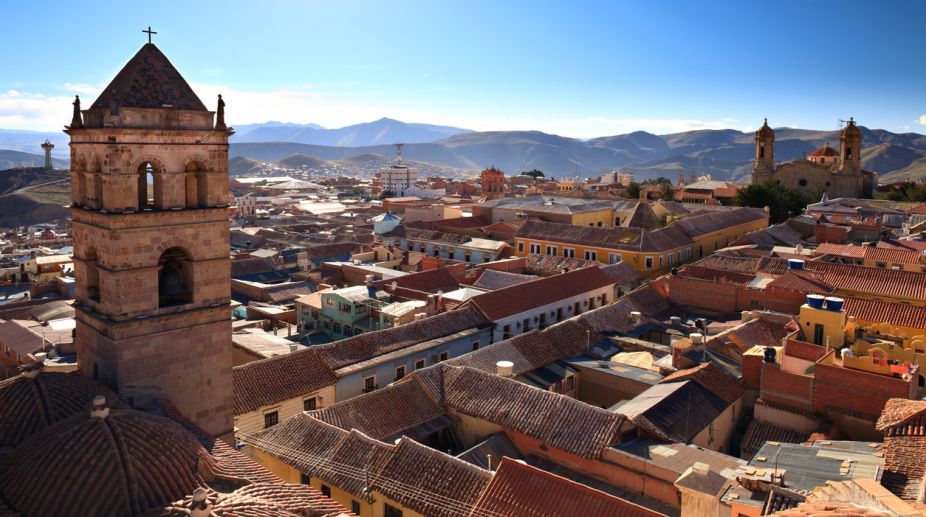In an effort to highlight places of interest in countries across the world, their varied culture, economy and history, The Statesman brings to you a Weekly Focus on countries with which India shares diplomatic ties and friendship. This week’s focus is on Bolivia. Know all about the country.
Capital: Sucre, Currency: Bolivian boliviano, Language: Spanish (official) 60.7 per cent, Quechua (official) 21.2, Aymara (official) 14.6, foreign languages 2.4, Guarani (official) 0.6,
Advertisement
Other native languages 0.4, none 0.1 Note: Bolivia’s 2009 constitution designates Spanish and all indigenous languages as official; 36 indigenous languages are specified, including some that are extinct (2001 est.)
Religion: Roman Catholic 76.8 per cent, Evangelical and Pentecostal 8.1, Protestant 7.9, other 1.7, none 5.5 (2012 est.) Ethnic groups: Mestizo (mixed white and Amerindian ancestry) 68 per cent, indigenous 20, white 5, other 7; 44 per cent of respondents indicated feeling part of some indigenous group, predominantly Quechua or Aymara (2009 est.).
Climate: Bolivia has a temperate climate but temperatures can differ dramatically between day and night. The wettest period is November to March, which, in extreme circumstances, may induce landslides in mountainous areas, and cause certain roads to become impassable. The northeast slopes of the Andes are semi-tropical. Winter is perhaps the best time to visit (May/October), especially in the hot and humid lowlands, as it is cooler and drier. In the highlands, it rains much less, remains sunny through the day but gets noticeably colder at night.
Festive spirits: Bolivia has a staggering amount of festivals throughout the year, from the spiritual and traditional, to the more wild and westernised, festivals are unique, colourful, and voracious. Main celebrations are Oruro Carnival, Alasitas in La Paz, Aymara New Year in La Paz and Tiwanaku, The Procession of el Gran Poder in La Paz, Urkupiña Festival in Quillacollo and Semana Santa. The Indian community in Bolivia is small, and consists of around 100 Indians engaged in retail trade, transport and agriculture. There are no direct flights to Bolivia from India.
Eclectic Cuisine: The highlands and lowlands each have their own flavours. Aymaran cuisine in the Andes and Altiplano is centred on potatoes, rice, quinoa and meat (mutton and llama). Food in the lowlands tends to be more tropical (yucca and plantain are staples) with beef featuring heavily. Vegetarian options are few outside the main cities.
While Bolivia is landlocked, fish is still readily available, including delicious trout from Lake Titicaca. Some of the specialities are Salteas, Api con buuelos, huo, Llawa, Lomomontado, uape, Surub, Picante de pollo, Lechn al horno, haruean and ate.
Bilateral relations: According to Department of Commerce, trade between India and Bolivia during the 2016-17 was $253.479 million, a decline of almost 20 per cent from $314.684 million in 2015-16. India mainly exports automobiles, iron and steel, pharmaceuticals, machinery, rubber and plastic products and yarns and textiles.
It imports gold, leather, fertiliser and animal feed from Bolivia. Pesticides company UPL has an office in Santa Cruz, Bolivia. Tata Motors has appointed a dealer in Bolivia. Similarly, Ashok Leyland has an accord with COFADENA to develop its business in the country. Bolivia has been allocated five slots in 2016-17 for civilian training under ITEC. The lighting of the Archaeological Complex of Tiwanaku on the shores of Lake Titicaca, undertaken with Indian assistance, was inaugurated on 21 June 2017. Another project for the solar lighting of Plazueladel Niño (Children’s Park) in Sucre is also being undertaken with Indian assistance. India also extended humanitarian assistance to Bolivia when the need arose.
Salar de Uyuni: Largest salt flat in the world: The expanse of salt creates an unending white landscape during the dry season, but the area is most breathtaking in the rainy season when it is covered in water. The reflection of the blue sky creates a spectacular and surreal landscape.
Some of the top attractions are Train cemetery, Uyuni Isla Incahuasi, Uyuni Eduardo AvaroaAndean Fauna National Reserve, Uyuni Laguna Verde Green Lagoon and Uyuni Laguna Colorada Red Lagoon.
La Paz: Administrative capital of Bolivia: Situated on steep hills at an elevation of roughly 3,650 m above sea level, highest de facto capital city in the world. Main attractions are Plaza Murillo, The Witches Market and the San Francisco Cathedral.
Tiwanaku: This World Heritage Site is an ancient pre-Columbian city in ruins near the south-eastern shore of Lake Titicaca. The city was built with stones weighing more than 25 tonne from the other side of the lake. Main highlights are The Akapana pyramid (largest building in Tiwanaku, Pumapunku or Puma Punku, The Gate of the Sun (Puertadel Sol) and The Kalasaya.
Other attractions are Lake Titicaca (largest lake in South America), Potosi (one of the world’s highest cities, that once housed over 60,000 tonnes of silver), Yungas Road(mountain bikers) and Madidi National Park.
(Compiled by Kunal Jain; kunaljain@thestatesman.com)











